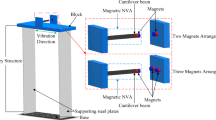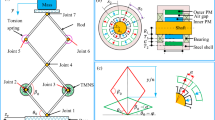Abstract
This paper proposes a novel bi-state nonlinear vibration isolator (BS-NVI) consisting of a linear mass–spring–damper and several permanent magnets (PMs). The working state of the BS-NVI can be monostable or bistable depending on the relative position of the PMs. The theoretical model of the BS-NVI is established. The transmissibility of the BS-NVI is derived according to the harmonic balance method. Both the simulation and experimental efforts are performed to study the nonlinear dynamics and vibration isolation performance of the BS-NVI. The results demonstrate that the monostable isolator acts like a quasi-zero-stiffness isolator and exhibits the hardening-spring-liked characteristic. With the change in the relative position of the PMs, the transmissibility and the peak frequency are decreased. However, the bistable isolator undergoes the interwell and intrawell oscillations with the change in the excitation amplitude and frequency. The motion of the bistable isolator can be periodic or chaotic. Due to the snap-through action, the transmissibility of the bistable isolator could be smaller than 1 in part of the resonance region.




























Similar content being viewed by others
Abbreviations
- BS-NVI:
-
Bi-state nonlinear vibration isolator
- HBM:
-
Harmonic balance method
- HSLDS:
-
High-static-low-dynamic stiffness
- PM:
-
Permanent magnets
- \(\hbox {PM}^{\mathrm{b}}\) :
-
Base PM
- \(\hbox {PM}^{\mathrm{M}}\) :
-
Moving PM
- QZS:
-
Quasi-zero-stiffness
References
Yan, B., Zhang, X.N., Niu, H.P.: Design and test of a novel isolator with negative resistance electromagnetic shunt damping. Smart Mater. Struct. 21(3), 035003 (2012). https://doi.org/10.1088/0964-1726/21/3/035003
Yan, B., Wang, K., Kang, C.X., Zhang, X.N., Wu, C.Y.: Self-sensing electromagnetic transducer for vibration control of space antenna reflector. IEEE/ASME Trans. Mechatron. 22(5), 1944–1951 (2017). https://doi.org/10.1109/Tmech.2017.2712718
Laalej, H., Lang, Z.Q., Daley, S., Zazas, I., Billings, S.A., Tomlinson, G.R.: Application of non-linear damping to vibration isolation: an experimental study. Nonlinear Dyn. 69(1), 409–421 (2012). https://doi.org/10.1007/s11071-011-0274-1
Mokni, L., Belhaq, M., Lakrad, F.: Effect of fast parametric viscous damping excitation on vibration isolation in SDOF systems. Commun. Nonlinear Sci. Numer. Simul. 16(4), 1720–1724 (2011). https://doi.org/10.1016/j.cnsns.2010.08.031
Ho, C., Lang, Z.-Q., Billings, S.A.: A frequency domain analysis of the effects of nonlinear damping on the Duffing equation. Mech. Syst. Signal Process. 45(1), 49–67 (2014). https://doi.org/10.1016/j.ymssp.2013.10.027
Virgin, L.N., Santillan, S.T., Plaut, R.H.: Vibration isolation using extreme geometric nonlinearity. J. Sound Vib. 315(3), 721–731 (2008). https://doi.org/10.1016/j.jsv.2007.12.025
Huang, X.C., Liu, X.T., Sun, J.Y., Zhang, Z.Y., Hua, H.X.: Effect of the system imperfections on the dynamic response of a high-static-low-dynamic stiffness vibration isolator. Nonlinear Dyn. 76(2), 1157–1167 (2014). https://doi.org/10.1007/s11071-013-1199-7
Hao, Z., Cao, Q.J., Wiercigroch, M.: Nonlinear dynamics of the quasi-zero-stiffness SD oscillator based upon the local and global bifurcation analyses. Nonlinear Dyn. 87(2), 987–1014 (2016). https://doi.org/10.1007/s11071-016-3093-6
Wang, X.L., Zhou, J.X., Xu, D.L., Ouyang, H.J., Duan, Y.: Force transmissibility of a two-stage vibration isolation system with quasi-zero stiffness. Nonlinear Dyn. 87(1), 633–646 (2016). https://doi.org/10.1007/s11071-016-3065-x
Wang, Y., Li, S., Neild, S.A., Jiang, J.Z.: Comparison of the dynamic performance of nonlinear one and two degree-of-freedom vibration isolators with quasi-zero stiffness. Nonlinear Dyn. 88(1), 635–654 (2016). https://doi.org/10.1007/s11071-016-3266-3
Esin, M., Pasternak, E., Dyskin, A.V.: Stability of chains of oscillators with negative stiffness normal, shear and rotational springs. Int. J. Eng. Sci. 108, 16–33 (2016). https://doi.org/10.1016/j.ijengsci.2016.08.002
Liu, C.R., Yu, K.P.: A high-static-low-dynamic-stiffness vibration isolator with the auxiliary system. Nonlinear Dyn. (2018). https://doi.org/10.1007/s11071-018-4441-5
Ding, H., Chen, L.Q.: Nonlinear vibration of a slightly curved beam with quasi-zero-stiffness isolators. Nonlinear Dyn. (2018). https://doi.org/10.1007/s11071-018-4697-9
Ding, H., Ji, J., Chen, L.Q.: Nonlinear vibration isolation for fluid-conveying pipes using quasi-zero stiffness characteristics. Mech. Syst. Signal Process. 121, 675–688 (2019). https://doi.org/10.1016/j.ymssp.2018.11.057
Carrella, A., Brennan, M.J., Waters, T.P.: Static analysis of a passive vibration isolator with quasi-zero-stiffness characteristic. J. Sound Vib. 301(3–5), 678–689 (2007). https://doi.org/10.1016/j.jsv.2006.10.011
Carrella, A., Brennan, M.J., Kovacic, I., Waters, T.P.: On the force transmissibility of a vibration isolator with quasi-zero-stiffness. J. Sound Vib. 322(4–5), 707–717 (2009). https://doi.org/10.1016/j.jsv.2008.11.034
Carrella, A., Brennan, M.J., Waters, T.P., Lopes, V.: Force and displacement transmissibility of a nonlinear isolator with high-static-low-dynamic-stiffness. Int. J. Mech. Sci. 55(1), 22–29 (2012). https://doi.org/10.1016/j.ijmecsci.2011.11.012
Kovacic, I., Brennan, M.J., Waters, T.P.: A study of a nonlinear vibration isolator with a quasi-zero stiffness characteristic. J. Sound Vib. 315(3), 700–711 (2008). https://doi.org/10.1016/j.jsv.2007.12.019
Kovacic, I., Brennan, M.J., Lineton, B.: Effect of a static force on the dynamic behaviour of a harmonically excited quasi-zero stiffness system. J. Sound Vib. 325(4), 870–883 (2009). https://doi.org/10.1016/j.jsv.2009.03.036
Gatti, G., Kovacic, I., Brennan, M.J.: On the response of a harmonically excited two degree-of-freedom system consisting of a linear and a nonlinear quasi-zero stiffness oscillator. J. Sound Vib. 329(10), 1823–1835 (2010). https://doi.org/10.1016/j.jsv.2009.11.019
Tang, B., Brennan, M.J.: On the shock performance of a nonlinear vibration isolator with high-static-low-dynamic-stiffness. Int. J. Mech. Sci. 81, 207–214 (2014). https://doi.org/10.1016/j.ijmecsci.2014.02.019
Lan, C.C., Yang, S.A., Wu, Y.S.: Design and experiment of a compact quasi-zero-stiffness isolator capable of a wide range of loads. J. Sound Vib. 333(20), 4843–4858 (2014). https://doi.org/10.1016/j.jsv.2014.05.009
Lu, Z.Q., Chen, L.Q., Brennan, M.J., Yang, T.J., Ding, H., Liu, Z.G.: Stochastic resonance in a nonlinear mechanical vibration isolation system. J. Sound Vib. 370, 221–229 (2016). https://doi.org/10.1016/j.jsv.2016.01.042
Lu, Z.Q., Shao, D., Ding, H., Chen, L.Q.: Power flow in a two-stage nonlinear vibration isolation system with high-static-low-dynamic stiffness. Shock Vib. 2018, 1–13 (2018). https://doi.org/10.1155/2018/1697639
Abbasi, A., Khadem, S.E., Bab, S., Friswell, M.I.: Vibration control of a rotor supported by journal bearings and an asymmetric high-static low-dynamic stiffness suspension. Nonlinear Dyn. 85(1), 525–545 (2016). https://doi.org/10.1007/s11071-016-2704-6
Araki, Y., Asai, T., Kimura, K., Maezawa, K., Masui, T.: Nonlinear vibration isolator with adjustable restoring force. J. Sound Vib. 332(23), 6063–6077 (2013). https://doi.org/10.1016/j.jsv.2013.06.030
Mofidian, S.M.M., Bardaweel, H.: Displacement transmissibility evaluation of vibration isolation system employing nonlinear-damping and nonlinear-stiffness elements. J. Vib. Control 24(18), 4247–4259 (2018). https://doi.org/10.1177/1077546317722702
Zhou, J.X., Wang, X.L., Xu, D.L., Bishop, S.: Nonlinear dynamic characteristics of a quasi-zero stiffness vibration isolator with cam–roller–spring mechanisms. J. Sound Vib. 346, 53–69 (2015). https://doi.org/10.1016/j.jsv.2015.02.005
Zhou, J.X., Xu, D.L., Bishop, S.: A torsion quasi-zero stiffness vibration isolator. J. Sound Vib. 338, 121–133 (2015). https://doi.org/10.1016/j.jsv.2014.10.027
Zhou, J.X., Xiao, Q.Y., Xu, D.L., Ouyang, H.J., Li, Y.L.: A novel quasi-zero-stiffness strut and its applications in six-degree-of-freedom vibration isolation platform. J. Sound Vib. 394, 59–74 (2017). https://doi.org/10.1016/j.jsv.2017.01.021
Sun, X.T., Jing, X.J., Xu, J., Cheng, L.: Vibration isolation via a scissor-like structured platform. J. Sound Vib. 333(9), 2404–2420 (2014). https://doi.org/10.1016/j.jsv.2013.12.025
Huang, X.C., Liu, X.T., Sun, J.Y., Zhang, Z.Y., Hua, H.X.: Vibration isolation characteristics of a nonlinear isolator using Euler buckled beam as negative stiffness corrector: a theoretical and experimental study. J. Sound Vib. 333(4), 1132–1148 (2014). https://doi.org/10.1016/j.jsv.2013.10.026
Carrella, A., Brennan, M.J., Waters, T.P., Shin, K.: On the design of a high-static-low-dynamic stiffness isolator using linear mechanical springs and magnets. J. Sound Vib. 315(3), 712–720 (2008). https://doi.org/10.1016/j.jsv.2008.01.046
Robertson, W.S., Kidner, M.R.F., Cazzolato, B.S., Zander, A.C.: Theoretical design parameters for a quasi-zero stiffness magnetic spring for vibration isolation. J. Sound Vib. 326(1), 88–103 (2009). https://doi.org/10.1016/j.jsv.2009.04.015
Zheng, Y.S., Zhang, X.N., Luo, Y.J., Yan, B., Ma, C.C.: Design and experiment of a high-static-low-dynamic stiffness isolator using a negative stiffness magnetic spring. J. Sound Vib. 360, 31–52 (2016). https://doi.org/10.1016/j.jsv.2015.09.019
Zhou, N.B., Liu, K.F.: A tunable high-static-low-dynamic stiffness vibration isolator. J. Sound Vib. 329(9), 1254–1273 (2010). https://doi.org/10.1016/j.jsv.2009.11.001
Wu, W.J., Chen, X.D., Shan, Y.H.: Analysis and experiment of a vibration isolator using a novel magnetic spring with negative stiffness. J. Sound Vib. 333(13), 2958–2970 (2014). https://doi.org/10.1016/j.jsv.2014.02.009
Zhou, J.X., Dou, L.L., Wang, K., Xu, D.L., Ouyang, H.J.: A nonlinear resonator with inertial amplification for very low-frequency flexural wave attenuations in beams. Nonlinear Dyn. 96(1), 647–665 (2019). https://doi.org/10.1007/s11071-019-04812-1
Yan, B., Ma, H.Y., Zhao, C.X., Wu, C.Y., Wang, K., Wang, P.F.: A vari-stiffness nonlinear isolator with magnetic effects: theoretical modeling and experimental verification. Int. J. Mech. Sci. 148, 745–755 (2018). https://doi.org/10.1016/j.ijmecsci.2018.09.031
Harne, R.L., Wang, K.W.: A review of the recent research on vibration energy harvesting via bistable systems. Smart Mater. Struct. 22(2), 023001 (2013). https://doi.org/10.1088/0964-1726/22/2/023001
Johnson, D.R., Thota, M., Semperlotti, F., Wang, K.W.: On achieving high and adaptable damping via a bistable oscillator. Smart Mater. Struct. 22(11), 115027 (2013). https://doi.org/10.1088/0964-1726/22/11/115027
Shaw, A.D., Neild, S.A., Wagg, D.J., Weaver, P.M., Carrella, A.: A nonlinear spring mechanism incorporating a bistable composite plate for vibration isolation. J. Sound Vib. 332(24), 6265–6275 (2013). https://doi.org/10.1016/j.jsv.2013.07.016
Johnson, D.R., Harne, R.L., Wang, K.W.: A disturbance cancellation perspective on vibration control using a bistable snap-through attachment. AMSE J. Vib. Acoust. 136(3), 031006 (2014). https://doi.org/10.1115/1.4026673
Yang, K., Harne, R.L., Wang, K.W., Huang, H.: Investigation of a bistable dual-stage vibration isolator under harmonic excitation. Smart Mater. Struct. 23(4), 045033 (2014). https://doi.org/10.1088/0964-1726/23/4/045033
Yang, K., Harne, R.L., Wang, K.W., Huang, H.: Dynamic stabilization of a bistable suspension system attached to a flexible host structure for operational safety enhancement. J. Sound Vib. 333(24), 6651–6661 (2014). https://doi.org/10.1016/j.jsv.2014.07.033
Wu, Z., Harne, R.L., Wang, K.W.: Excitation-induced stability in a bistable duffing oscillator: analysis and experiments. J. Comput. Nonlinear Dyn. 10(1), 011016 (2014). https://doi.org/10.1115/1.4026974
Chen, L.Q., Jiang, W.A.: Internal resonance energy harvesting. ASME J. Appl. Mech. 82(3), 031004 (2015). https://doi.org/10.1115/1.4029606
Benacchio, S., Malher, A., Boisson, J., Touzé, C.: Design of a magnetic vibration absorber with tunable stiffnesses. Nonlinear Dyn. 85(2), 893–911 (2016). https://doi.org/10.1007/s11071-016-2731-3
Le, T.D., Ahn, K.K.: A vibration isolation system in low frequency excitation region using negative stiffness structure for vehicle seat. J. Sound Vib. 330(26), 6311–6335 (2011). https://doi.org/10.1016/j.jsv.2011.07.039
Nayfeh, A.H., Mook, D.T.: Nonlinear Oscillations. Wiley, New York (1979)
Brennan, M.J., Kovacic, I., Carrella, A., Waters, T.P.: On the jump-up and jump-down frequencies of the Duffing oscillator. J. Sound Vib. 318(4), 1250–1261 (2008). https://doi.org/10.1016/j.jsv.2008.04.032
Yan, B., Zhou, S.X., Litak, G.: Nonlinear analysis of the tristable energy harvester with a resonant circuit for performance enhancement. Int. J. Bifurc. Chaos 28(07), 1850092 (2018). https://doi.org/10.1142/s021812741850092x
Acknowledgements
This work was supported by the National Natural Science Foundation of China under Grant No. 11602223.
Author information
Authors and Affiliations
Corresponding author
Ethics declarations
Conflict of interest
The authors declare that they have no conflict of interest.
Additional information
Publisher's Note
Springer Nature remains neutral with regard to jurisdictional claims in published maps and institutional affiliations.
Appendix A: Effect of higher-order terms of nonlinear restoring force on the response of the isolator
Appendix A: Effect of higher-order terms of nonlinear restoring force on the response of the isolator
Figure 28a shows the comparison of the nonlinear restoring force between the ninth-order and cubic polynomial fits, where \(D=28.6\,\hbox {mm}\), \(H=13\,\hbox {mm}\). The corresponding nonlinear stiffness coefficients are listed in Table 4. It demonstrates that the accuracy of the ninth-order polynomial is better than that of the cubic polynomial fit. Based on these two kinds of polynomial fit shown in Fig. 28a and Table 4, the displacement bifurcation diagram is plotted when the excitation frequency is 5Hz and the result is presented in Fig. 28b. One can clearly see that these two nonlinear dynamic responses are totally different with each other. The results imply that the ninth-order polynomial fit could more exactly describe the nonlinear restoring force and nonlinear dynamic responses.
Rights and permissions
About this article
Cite this article
Yan, B., Ma, H., Jian, B. et al. Nonlinear dynamics analysis of a bi-state nonlinear vibration isolator with symmetric permanent magnets. Nonlinear Dyn 97, 2499–2519 (2019). https://doi.org/10.1007/s11071-019-05144-w
Received:
Accepted:
Published:
Issue Date:
DOI: https://doi.org/10.1007/s11071-019-05144-w




